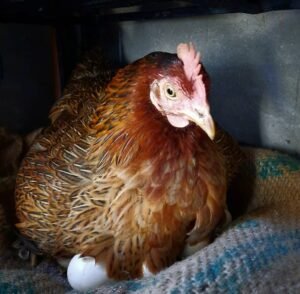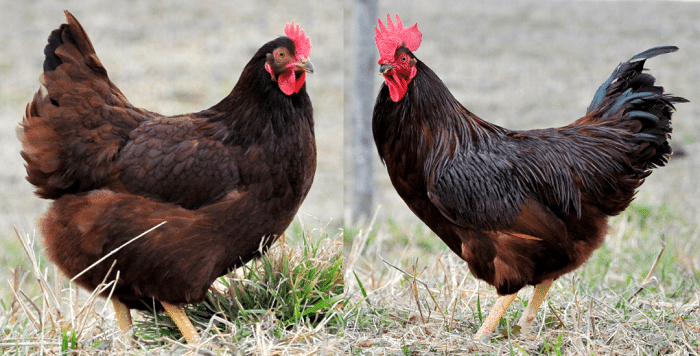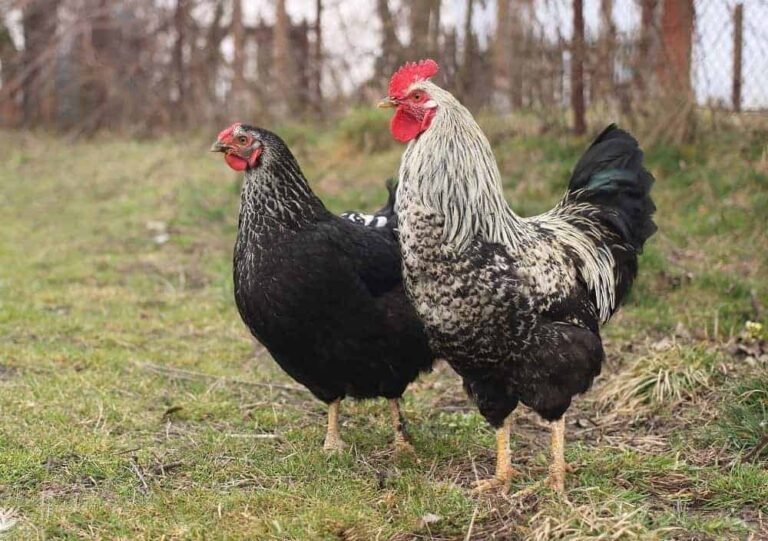Battling Fowl Pox Disease: The Expert Tips You Need to Protect Your Poultry

Fowl pox, like every other chicken disease, can massively destroy your poultry farm. So, If you suspect that your chickens are suffering from fowl pox disease, then this article is for you.
Even though your birds are not suffering from fowl pox disease, this guide will help you to know basic things about this disease. After all, gaining relevant knowledge in poultry farming is very important for success. Hence, learning about fowl pox disease is not a bad idea.
This guide will explain what fowl pox is all about, its causes, symptoms, and possible remedies. With the things you will learn from this guide, you can diagnose fowl pox disease quickly. As a result, you will be able to remedy the situation before things get out of hand.
So, if you are ready to learn everything about fowl pox disease, let’s get started.
What is fowl pox?
Fowl pox is a viral infection that affects the skin of chickens, especially in areas where there are no feathers. This disease can occur in all birds regardless of their age, especially during the rainy days of the year.
It usually enters the body of chickens through open wounds that exist on the body of the chicken. When this disease affects your chicken, it causes sores to appear on the comb, wattle, and beak of the chickens.
What are the causes of fowl pox disease and how does it spread?
1. Mosquitoes are the primary cause of fowl pox disease:
The main cause of fowl pox disease is primarily biting mosquitoes. Mosquitoes suck the blood of infected chickens from the wild or other farms and then transfer it to your flock.
They are able to transfer this disease to your chickens because after feeding on an infected bird, they are able to keep the virus in their salivary glands for up to 8 weeks.
2. Introduction of an infected bird in the flock:
Another way your chickens can contract fowl pox disease is by adding a bird with the infection to the flock. As the birds mix with other chickens in the flock, they too can become infected.
3. Open injuries, mucus, pecking, feather dander, etc:
Fowl pox disease can spread through injuries, mucus, feather pecking, etc. When a healthy bird comes in contact with these things, it can become sick with the disease.
4. Chickens can become infected by ingesting the fowl pox scabs:
After the fowl pox scabs fall off from an infected chicken, another chicken may mistakenly ingest the disease the spread continues. v That is why it is best to remove all infected birds immediately from the rest of the flock to save your chickens.
5. Human vectors:
Allowing anyone and everyone into your chicken house can bring this disease to your farm.
Without proper biosecurity, people can introduce the disease to your farm from their boots, cloth, or equipment used for an infected chicken.
6. Stress in chickens can cause fowl pox:
When your chicken chickens are under stress, they are susceptible to any kind of chicken disease.
This is because their body becomes weak to fight back these pathogens.
Also, while some chickens acquire immunity after some time, others are likely to be affected by recurrences in times of stress.
What are the symptoms of fowl pox?
Birds with this disease often exhibit some form of discomfort which may include the following;
1. Chickens with fowl pox disease experience poor growth:
Fowl pox disease disrupts the normal body operation of chickens.
As a result of this virus, they may have stunted growth.
2. Poor feed conversion:
Fowl pox, especially the wet type can cause lesions in the mouth part of chickens.
As a result, the chickens may not be able to feed properly and digest food.
This usually leads to poor food conversion and weight loss.
3. Injuries on the body of the chicken:
Fowl pox causes a lot of lesions and abrasions.
Open wounds and cuts will appear mostly on the areas of the chicken that is not covered with feathers, e.g, the beak, comb, wattle, and sometimes the legs.
4. Poor egg production:
If you have egg-laying chicken breeds, then you mean to notice a drop in the production of eggs.
Generally, egg production is affected when chickens are sick, infection with fowl pox disease is not an exception.
5. Lack of appetite:
With lots of cuts and injuries around the mouthparts, it is difficult for chickens with fowl pox disease to eat.
As a result, it reduces their appetite for both food and water, thereby making them lose weight.
These symptoms generally persist for several weeks in a bird and months in flocks.
However, death may occur if the oral cavity or air passage becomes involved.
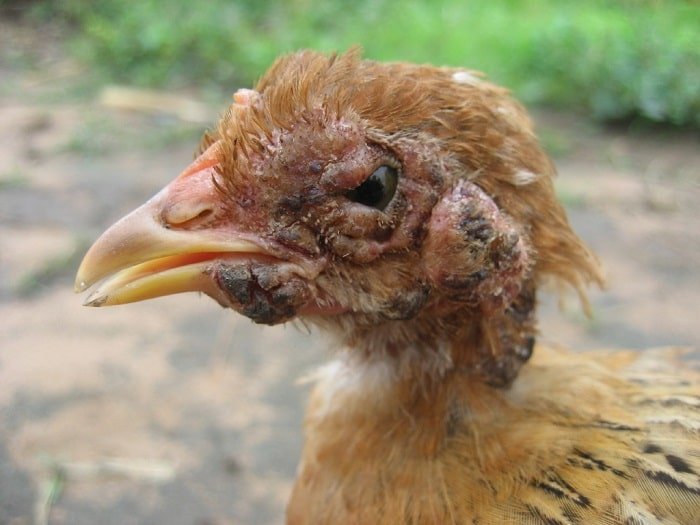
What are the preventive measures in handling the spread of fowlpox?
To prevent or avoid the spread of this disease in your poultry animals, kindly register these in your thought.
1. Ensure that you have a clean environment:
We now know that mosquitoes are the primary cause of fowl pox disease.
Hence, it makes sense to ensure that the poultry barn is clean at all times.
Ensure that there is no stagnant water sitting close to your poultry house.
Dispose of trash and dirty water that can attract mosquitoes very far away from the chicken house.
2. Follow strict biosecurity measures:
You can prevent the spread of fowl pox diseases by following strict biosecurity measures on your farm.
Ensure that anyone entering the farm is thoroughly disinfected.
For more assurance, have a special dressing, shoes, and other equipment which you only use in your poultry farm.
3. Quarantine sick chickens quickly:
It is a good practice to always have a quarantine unit in your poultry barn.
So, when a bird is sick, you can quickly remove the bird from the flock and save others from getting infected.
4. Control the spread of biting insects:
Insects, after perching on an infected bird, can carry the disease to another chicken.
The availability of biting insects, especially mosquitoes, is caused by the storage of dirty water for a long time.
The mosquitoes can lay eggs on it making them increase in numbers carrying them from one chicken to another.
You can control these biting insects by fumigating the environment around the farm.
You can also use non-toxic insect killers to wade off mosquitoes from the farm.
5. Vaccinate your chickens periodically:
Provide protection for your flock medically.
Administering vaccines to your chickens helps to boost their immune system in fighting against this disease.
Just make sure that you are following a strict vaccination schedule according to the prescription of the vet.
Also, if you don’t know how to administer the fowl pox vaccine, then you may need to invite a vet.
What are the possible treatments for fowl pox disease?
There is no specific cure for fowl pox but there are some comfort measures that you can provide for chickens that are affected.
1. Administer tetracycline:
You can give sick chickens tetracycline antibiotics in the water.
Also, you need to give them some vitamin supplements afterward.
2. Treat scabs with diluted iodine solution:
Usually, fowl pox disease causes lesions and injuries on the birds.
You can use an iodine solution to clean the injuries on the birds so that they heal quickly.
3. Apply ointment to soften scabs:
You can apply ointments like Bacitracin or Neosporin on the wounds to soften the scabs.
The is will help to prevent dry scabs from tearing the skin of the chicken and causing injuries.
4. Mix iodine in water:
By mixing diluted iodine solution into flocks drinking water helps to strengthen the flock more.
You need to give your birds this solution every day until the disease outbreak subsides.
5. Provide the chickens with vitamin supplements:
To help boost the immune system of the birds, provide them with vitamin supplements.
Building the immune system of the chickens helps them in fighting against this disease.
Vitamins like vitamins A, B, D, and E will help boost their respiratory system and help promote rapid healing.
6. Provide antibiotics for the chicken:
Antibiotics are great for treating and preventing some types of bacterial infections.
Applying them to the injuries on the chicken will prevent further infections.
What are the two forms of fowl pox?
There are two types of fowl pox and each of them can affect your chickens.
They are dry (cutaneous) fowl pox and wet (diphtheritic) fowl pox.
Your birds can be infected with both forms of the disease at the same time.
Also, it is still possible for an individual bird to be infected with both the dry and wet forms of fowl pox.
When your chicken contract this infection (in either form) it will lead to a loss in appetite, weight loss, and a drop in egg production.
Let’s see each of the two types of fowl pox in detail…
1. Dry or cutaneous fowl pox:
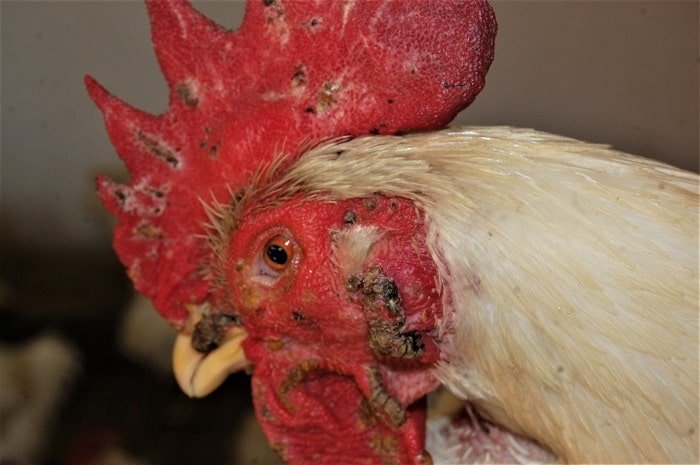
This is the most common form of fowl pox disease that affects chickens.
Chickens with this dry fowl pox usually have lesions on areas of the head, legs, and body that do not have feathers. A lesion is a part of the skin that has an abnormal growth or appearance compared to the skin around it.
The lesions begin as small blisters and then progress into wart-like growths on the skin of any unfeathered area (face, comb, wattles, eyelids, feet, and legs).
How does dry fowl pox form?
The formation of dry fowl pox begins with wart-like growths that appear as small, yellow bumps on the unfeather areas of the chicken.
These wart-like growths continue to increase in size over time, often changing color as they grow larger.
It gets to the point where the color changes to dark brown, forming dry scabs that appear roughened.
The scabs usually last about 2 to 4 weeks on the chicken and then drop off on their own.
If the growth happens close to the eyes of the chicken, then the eyelids may become sealed shut until the scab falls off.
The scabs that drop off usually contain the poxvirus and are highly infectious to other birds in the flock.
So, even though individual birds infected with dry pox may recover in 2 to 4 weeks, it may take several weeks or months for the entire flock to recover.
This is because the fowl pox virus spreads slowly throughout the flock.
2. Wet or diphtheritic fowl pox:

Wet fowl pox is deadlier than dry fowl pox.
Cases of wet fowl pox in your flock can easily lead to high poultry mortality on your farm.
Wet pox causes throat and respiratory tract lesions in your chickens.
It often begins as a small, white nodule and then develops into large patches that look like yellow, cheesy masses or growths.
These growths may become severe enough to interfere with eating, drinking, and breathing.
Severe cases of wet pox will likely result in the death of the affected birds.
Frequently asked questions about the fowlpox disease
Can fowl pox be transmitted to humans?
Not exactly, fowl pox cannot be transmitted to humans as it is a disease that affects only chickens. However, humans can transmit it to chickens.
How?
Humans can bring the disease into the farm through infected boots, clothes, and farm equipment.
It can start its effect from a chicken and then spread to the entire flock.
Therefore, it is advised to ensure proper sanitation in the poultry farm.
Can fowl pox kill chickens?
Actually, yes, fowlpox can kill chickens.
It would start by weakening the immune system of the affected chicken.
This way, the bird will lack the ability to fight against the disease thereby making the chicken lay almost lifeless on the floor.
Conclusion
Fowl pox is a disease of chickens that leads to economic losses if care is not taken.
But, guess what? You can prevent losses on your poult farm. All you need to do is to practice a proper farm management routine. Also, ensure to put all the preventive measures in this guide into action.
With these tips, you tend to reduce or rather eliminate the spread of this disease.
References:
- 12 Best Chicken breeds for Eggs – chicken breeds for eggs
- When Do Chickens Start Laying Eggs Regularly?
- How Many Eggs Does A Chicken Lay In A Week?
- Fermenting chicken feed – The definitive guide
- 10 Sure Ways To Stop Chickens from Eating Their Eggs [+Bonus]
- 6 Best Chicken Egg Incubators for Chicken Eggs and Other Birds
